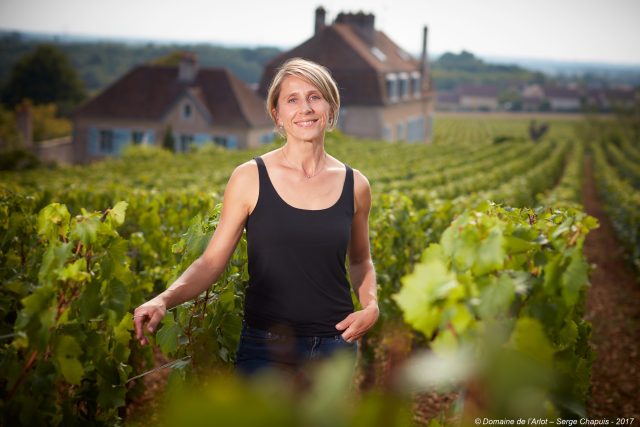This website uses cookies so that we can provide you with the best user experience possible. Cookie information is stored in your browser and performs functions such as recognising you when you return to our website and helping our team to understand which sections of the website you find most interesting and useful.
‘We have to be confident in nature’ says winemaker after bountiful vintage in Burgundy
Despite drought and heatwaves, last year’s harvest in Burgundy has produced a crop that’s both bountiful and brilliant, encouraging Domaine de l’Arlot’s Géraldine Godot to have confidence in the vine’s ability to adapt to climatic extremes.

Godot, who manages the wines at the AXA-owned Domaine de l’Arlot, which is based in Nuits-Saint-Georges, expressed her surprise at the quality and quantity of the 2022 vintage in Burgundy during a discussion with the drinks business in London last month.
Having presented a set of wines to diners at Cabotte on 23 Febuary, db quizzed Godot about the latest harvest at Domaine de l’Arlot, a 14-hectare biodynamic property which produces mostly red wines, but also, unusually for Nuits-Saint-Georges, a white wine too.
Comparing 2022 to 2021 – which has just been presented to the trade in London as part of January’s Burgundy En Primeur Week – she said that the most recent vintage was as good as 2021, but double the size.
In terms of exact yields, this meant a jump from 19.5hl/ha in the frost-struck 2021 harvest to 40hl/ha in 2022, with the lastest vintage producing around 65,000 bottles of Domaine de l’Arlot, compared to an average of around 45,000 bottles “over the last few years” according to Godot.
With the vines in Burgundy exposed to a series of heatwaves last year, and extremely dry conditions for much of the growing season, Godot was braced for an early harvest, along with low yields due to desiccated grapes.
However some heavy rain in June was enough to prevent the berries shrivelling, while unusually high summertime temperatures actually slowed down the ripening process in the grapes – when the mercury rises above 35 degrees Celsius, the vine can stop photosynthesising to conserve water, effectively shutting down the plant.
Godot recalled, “We thought the grapes would be dried out, but it seems we had just enough rain to prevent that from happening, and we thought we would have to harvest in August, but because it was so hot in the summer, almost 40 degrees Celsius – the plants stopped maturing.”
Such factors, combined with a healthy fruit set – despite some late spring frost – meant that the maturation process was not too rapid, which ensured that grape sugars rose in line with the ripening of phenolics in the fruit.
“Because we had double the quantity of 2021, the maturity was not so obvious, we did not have enough sugar in the berries in the middle of August, but, had we had the same amount of grapes as 2021, then we would have had to harvest in August,” she said.
“There is a link between maturity, sugar, alcohol and the yield – the lower the yield, the more we have to pay attention to the maturity,” she added.
Speaking further about the vines ability to handle temperature extremes and limited amounts of water, she said, “I am always surprised to see the capacity of the vineyard to adapt – we had no problems with colour in the vineyard, which remained a good green, and we had no dried berries.”
Continuing she said, “We speak about global warming, but maybe we have to be confident in nature; it seems the vineyard can adapt in a better way than us.”
Nevertheless, she said that recent yields at Domaine de l’Arlot had been “almost nothing”, recording that the “last good year” in terms of production volumes at the estate was 2009, when, like last year, the property harvested 40hl/ha.
“In ’21 we had frost, in ’20 we had a heatwave, in ’19 we had frost, in ’18 we had hail storms, ’17 was good, ’16 we had frost, ’15 we had a heatwave, and ’14 was quiet but we had rain in summer – so, you see, every year is difficult,” she said.
Finally, she recorded variability in Burgundy not just over time, but across space too, as she told db that extreme weather events can be very localised, while some areas are more frost-prone than others.
“You can have a violent event for just one village; you can be very close, but climatic conditions can be very different,” she said.
Concluding, she commented, “It is more and more difficult to have a general idea of Burgundy.”
According to the Bourgogne Wine Board (BIVB), 2022 yield “a high-quality, generous vintage.”
In the association’s harvest report, it noted that the previous three years had seen “volumes unfortunately impacted by the whims of the weather,” making the bountiful 2022 vintage “very welcome indeed”.
“It removes some of the pressure from the market and will allow producers to restock,” it stated.
Continuing, the vintage report noted, “The weather over the year was once again intense, fluctuating between frost, heatwaves, and drought. Budburst was later than in previous years, which helped somewhat to protect the vines from the April frost. Then, thanks to the alchemy between vines and terroir in the Bourgogne winegrowing region, they emerged unscathed from four periods of heatwave and a general lack of rainfall.”
As a result, it said that “In general, the musts were balanced, with a good degree of potential alcohol. The wines are beautifully crafted, with good concentration and perfect balance.
Summing up it concluded that “The 2022 is an astonishing vintage. Despite the heat over the year, its fresh fruit aromas and lovely vigour ensure it will have a fine future.”
Read more

